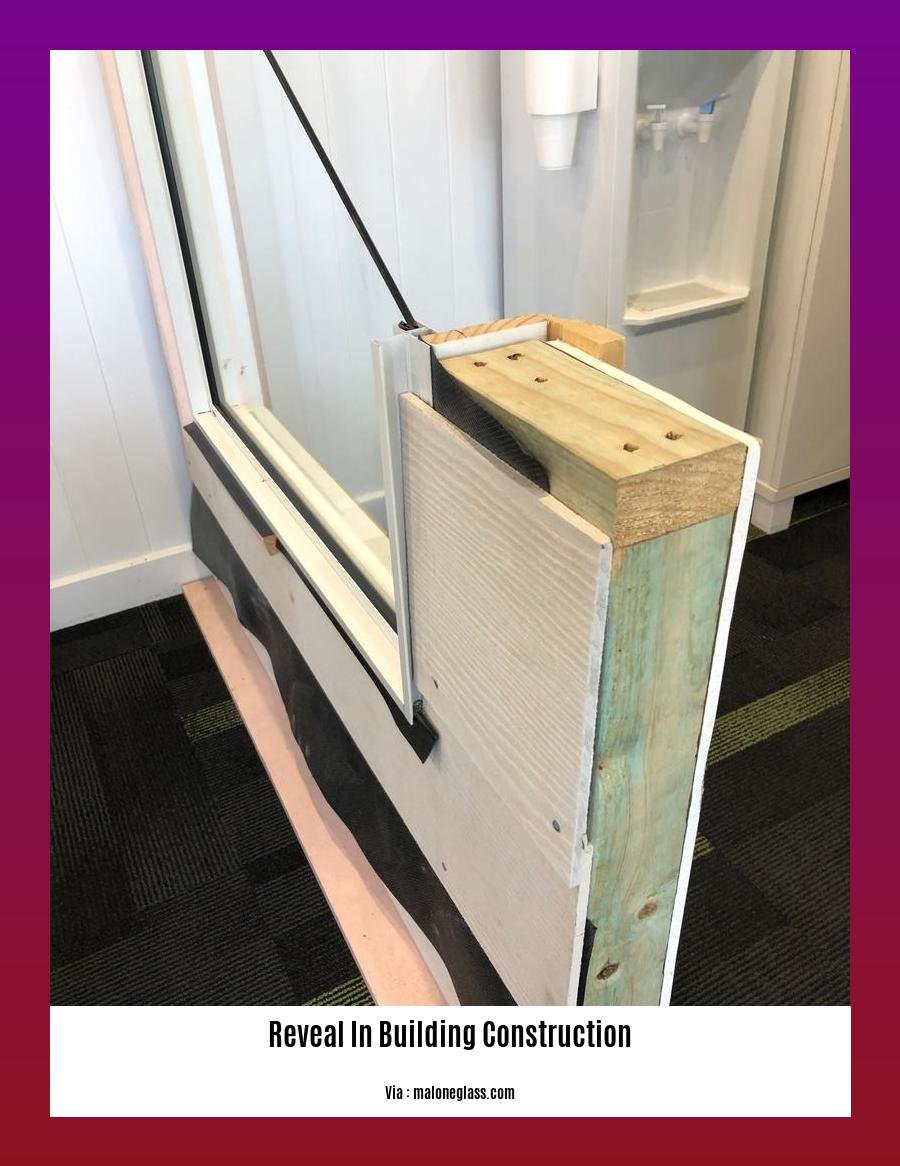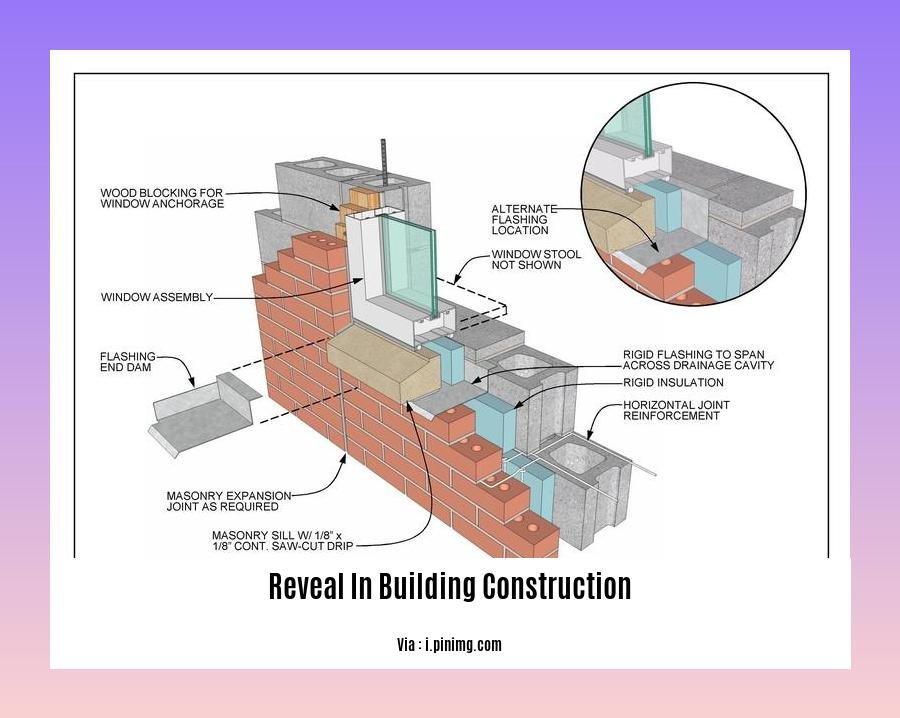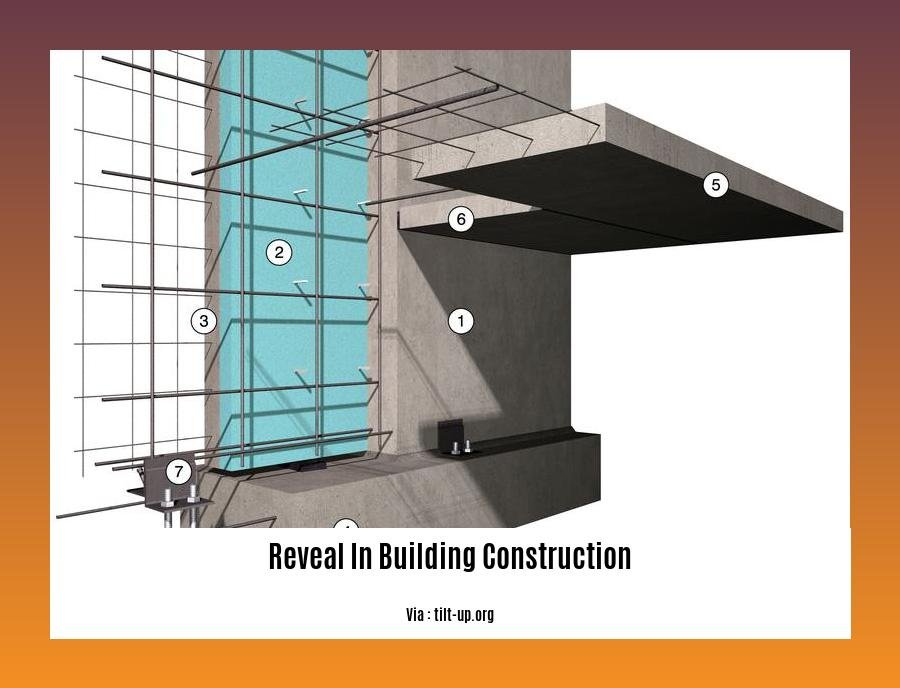– The Essential Guide to Reveal Design in Building Construction
Key Takeaways:
- Reveals in construction create recessed areas around windows or doors, adding visual interest and shadow lines.
- They exist both as exterior window components and as timber surrounds for installation in framing.
- Reveals provide ventilation, drainage, and protection for windows and doors, extending their lifespan.
- They improve durability and prevent moisture penetration.
- Different types of reveals include window reveals and door reveals.
Reveals in Building Construction

So, what exactly is a reveal in building construction? In simple terms, a reveal is an indented or recessed area within a building design, typically found embellishing windows or doors. This architectural design element not only plays a pivotal role in a building’s aesthetics but also serves a significant functional purpose.
Aesthetic Appeal: Reveals lend a touch of visual intrigue to architectural elements. The play of shadows and depths they create enhances the overall beauty and sophistication of the building’s façade.
Protection and Functionality: Beyond their aesthetic appeal, reveals play a crucial role in protecting windows and doors from the elements. By creating a barrier between the exterior and interior, reveals shield these essential building components from weathering, water penetration, and wear and tear, effectively extending their lifespan.
Types of Reveals:
-
Window Reveals: These recesses around window openings serve two vital purposes: ventilation and drainage. Adequate ventilation prevents condensation and ensures proper airflow, while effective drainage safeguards the window from water damage.
-
Door Reveals: Indentations around door frames enhance durability and prevent moisture penetration. They provide additional protection against the elements, ensuring the door’s longevity and functionality.
Key Considerations in Reveal Design:
-
Material Selection: Choosing the appropriate material for reveals is crucial. Common choices include wood, metal, or stone, each offering unique advantages to suit different architectural styles and functional requirements.
-
Size and Depth: The size and depth of the reveal should be carefully considered to balance aesthetics and functionality. Larger reveals create a more pronounced shadow line, while deeper reveals provide better protection.
-
Installation: Proper installation of reveals is paramount. Skilled craftsmanship is required to ensure correct alignment, precise fitting, and secure attachment to the surrounding structure.
-
Maintenance: Regular maintenance is essential to preserve the integrity and aesthetics of reveals. Cleaning, sealing, or repainting as needed helps maintain their original condition and prolong their lifespan.
By carefully considering these factors, architects and builders can design and implement reveals that seamlessly integrate with the overall building design, enhancing both the aesthetics and functionality of the structure.
-
Looking to save some money on your next construction project? Learn all about rebate meaning in construction and how you can take advantage of them.
-
If you’re dealing with a construction project that has gone awry, you may need to undertake remedial works in construction. Find out what they are and how they can help.
-
Building a new home? Learn more about residential roof construction and the different types of roofs available.
-
Want to make your home more energy-efficient? Consider a retrofit. Find out what it is and how it can benefit you.
-
Not sure whether to replace your old windows or install new ones? Here’s a comparison of retrofit vs new construction windows to help you decide.
-
What is a reveal in construction? Find out how it can enhance the aesthetics of your building.
-
If you’re planning a road construction project, you’ll need the right road construction equipment. Find out what you need and how to choose the best equipment for your project.
Installation Techniques

Reveal applications in building construction demand precision and attention to detail to achieve the desired architectural effect. The installation process is crucial, as it ensures the reveal’s proper functioning and aesthetics.
1. Material Selection:
The choice of material for your reveals depends on the overall design intent and budget. Gypsum board, wood, and metal are common choices, each with its advantages and disadvantages. Consider factors like durability, moisture resistance, and fire resistance.
2. Sizing and Placement:
Determine the reveal’s size and placement based on design requirements. The reveal’s depth and width should enhance the architectural features without overpowering them. Consider the surrounding elements and overall visual balance.
3. Framing and Anchoring:
Create a solid framing system to support the reveal. Use appropriate fasteners and anchors to ensure proper attachment. Precision in framing is essential to prevent sagging or shifting over time.
4. Surface Preparation:
Prepare the surfaces where the reveal will be installed by ensuring they are clean, level, and free of debris. This ensures a strong bond between the reveal and the substrate.
5. Installation:
Install the reveal carefully, following the manufacturer’s instructions. Use a level to ensure accuracy and avoid any misalignment. Secure the reveal using appropriate fasteners and sealants around the edges to prevent water infiltration.
6. Trim and Finish:
Trim the reveal to fit precisely around the opening. Use appropriate moldings or trims to enhance the aesthetics and provide a clean, finished look. Seal the gaps between the reveal and surrounding elements to prevent drafts and moisture penetration.
KeyTakeaways:
-
Precision is key in reveal installation to achieve the desired architectural effect.
-
Material selection should consider durability, moisture resistance, and fire resistance.
-
Proper framing and anchoring ensure the reveal’s stability and longevity.
-
Surface preparation before installation prevents bonding issues.
-
Careful installation and sealing prevent drafts and moisture infiltration.
Relevant URL Sources:
Material Selection and Performance in Reveal Design
Selecting the right materials for reveals is crucial as they impact the overall performance of the building. Consider the following factors when choosing reveal materials:
- Durability: Reveals are exposed to weathering elements, so choose durable materials like stone, metal, or moisture-resistant wood.
- Thermal Performance: If thermal insulation is a priority, opt for materials with low thermal conductivity, such as fiberglass or cellular PVC.
- Fire Resistance: In areas where fire resistance is essential, consider materials like steel, concrete, or gypsum board.
- Sustainability: Choose materials that are environmentally friendly and recyclable, such as recycled plastic or sustainable wood sources.
Key Takeaways:
- Material selection for reveals should prioritize durability, thermal performance, fire resistance, and sustainability.
- Common reveal materials include stone, metal, wood, fiberglass, cellular PVC, steel, concrete, and gypsum board.
- The specific material choice depends on the specific performance requirements of the project.
Relevant URL Sources:
- Construction Materials
- Sustainable Building Materials
Reveal Design Best Practices
Planning a reveal for your next or upcoming construction building project? Here’s a concise guide packed with insights to help you achieve stunning results:
Planning and Preparation
- Define your vision: Determine your desired architectural style, element proportions, and visual impact for your reveals.
- Consider Material Selection: Research various materials, their properties, and suitability for your project’s design and environment. Wood, metal, or stone can add unique character and functionality to your reveals.
- Determine Size and Depth: Plan for appropriate reveal dimensions based on your architectural design, taking into account aesthetics, functionality, and ease of maintenance.
- Proper Installation Techniques: Follow industry guidelines and best practices for reveal installation. Ensure precise alignment, secure fittings, and durable attachments to enhance lifespan and visual appeal.
Key Takeaways:
- Reveal Design Best Practices: A well-designed reveal can enhance the architectural aesthetics and visual interest of a building.
- Material considerations: Selecting the right materials for your reveal is crucial for durability, functionality, and aesthetics.
- Installation techniques: Proper installation techniques ensure that your reveal will last and perform as intended.
Sources
FAQ
Q1: What is the primary purpose of a reveal in building construction?
A1: The primary purpose of a reveal in building construction is to enhance architectural details and add visual interest to specific elements within a structure.
Q2: Where are reveals commonly used in construction projects?
A2: Reveals are commonly used in walls, ceilings, windows, doors, baseboards, crown molding, and recessed lighting to create visual depth and highlight certain features.
Q3: What are the different types of reveals used in construction?
A3: Reveals vary based on design and materials used. They can be made from gypsum board, wood, or metal, and can take on different shapes and sizes to suit the specific architectural style and purpose.
Q4: How does the design of a reveal impact the overall aesthetics of a building?
A4: The design of a reveal can significantly influence the overall aesthetics of a building by creating shadows and depth, emphasizing architectural elements, and adding a touch of elegance and sophistication.
Q5: What factors should be considered when selecting materials for a reveal?
A5: When selecting materials for a reveal, factors such as durability, strength, thermal performance, and environmental impact should be considered to ensure the reveal’s longevity, functionality, and alignment with sustainable building practices.
- Are Daffodils Perennials?A Complete Guide to Planting & Care - March 31, 2025
- Are Carpenter Bees Dangerous? Stings, Damage, and Control - March 31, 2025
- How to Get Rid of Ants in the Washroom: A Complete Guide - March 31, 2025










